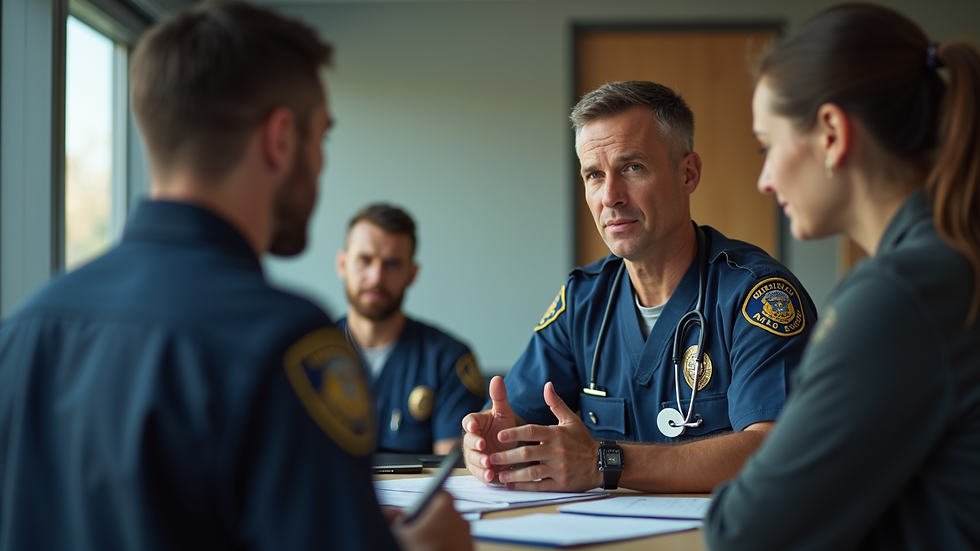Understanding Disaster Relief Programs
- rich alvarez
- Oct 6
- 3 min read
Disasters strike unexpectedly, leaving devastation in their wake. For first responders, veterans, and their supporters, understanding how disaster aid programs work is crucial. These programs provide essential support during crises, helping communities recover and rebuild. Beyond immediate relief, they also offer ongoing assistance tailored to the unique needs of those who serve and protect. This article explores the nature of disaster aid programs, their importance, and how initiatives like the Peacekeeper Initiative are making a difference.
The Role of Disaster Aid Programs in Crisis Response
Disaster aid programs are designed to provide timely assistance to individuals and communities affected by natural or man-made disasters. These programs often include emergency shelter, food distribution, medical care, and mental health support. For first responders and veterans, who frequently face high-stress situations, these programs can be a lifeline.
One key aspect of disaster aid programs is their focus on peer support and wellness activities. These help reduce stress and promote mental health resilience. For example, the Peacekeeper Initiative offers peer support groups and stress-relieving wellness activities specifically for first responders and veterans. These services are vital in helping individuals cope with trauma and maintain their well-being during and after disasters.

How Disaster Aid Programs Support First Responders and Veterans
Disaster aid programs go beyond immediate relief by addressing the long-term needs of first responders and veterans. These individuals often face unique challenges, including exposure to traumatic events and physical injuries. Programs that focus on mental health first aid and peer support can significantly improve their recovery and quality of life.
The Peacekeeper Initiative, for example, offers Mental Health First Aid classes that equip first responders and veterans with the skills to recognize and respond to mental health crises. This training empowers them to support their peers effectively, creating a stronger, more resilient community.
Additionally, the initiative maintains a gifted boat used to take first responders and veterans on therapeutic outings on the water. These experiences provide a peaceful environment for relaxation and camaraderie, which are essential for stress relief and healing.

What are the examples of disaster relief?
Disaster relief encompasses a wide range of activities aimed at mitigating the impact of disasters. Some common examples include:
Emergency Shelter and Housing - Providing temporary housing for displaced individuals.
Food and Water Distribution - Ensuring access to essential supplies.
Medical Assistance - Offering urgent medical care and ongoing health services.
Mental Health Support - Delivering counseling, peer support, and stress management programs.
Infrastructure Repair - Rebuilding damaged roads, bridges, and public facilities.
Community Outreach and Education - Informing the public about preparedness and recovery resources.
For first responders and veterans, specialized programs like peer support groups and wellness activities are critical components of disaster relief. These efforts help address the emotional and psychological toll disasters can take on those who serve.

How You Can Help Fund Disaster Aid Programs
Supporting disaster aid programs is essential to ensure they continue providing vital services. Donations help fund peer support initiatives, wellness activities, and educational classes like Mental Health First Aid. They also contribute to maintaining resources such as the Peacekeeper Initiative’s boat, which offers therapeutic outings for first responders and veterans.
Here are practical ways to contribute:
Donate Online: Visit the Peacekeeper Initiative’s website to make a secure donation.
Organize Fundraisers: Host events to raise awareness and funds for disaster aid programs.
Volunteer: Offer your time and skills to support program activities and outreach.
Spread the Word: Share information about these programs within your community and social networks.
Every contribution, no matter the size, helps sustain these critical services and supports those who dedicate their lives to protecting others.
The Importance of Community in Disaster Recovery
Recovery from disaster is not just about rebuilding structures but also about restoring the strength and spirit of the community. For first responders and veterans, community support plays a vital role in healing and resilience.
Programs like the Peacekeeper Initiative foster a sense of belonging and mutual support. Through peer groups, wellness activities, and shared experiences on the water, participants build connections that help them navigate the challenges of recovery.
By investing in these programs, donors help create a network of care that extends beyond the immediate aftermath of a disaster. This network is essential for long-term recovery and well-being.
Supporting disaster aid programs is a powerful way to honor and assist those who serve. By contributing to initiatives like the Peacekeeper Initiative, you help provide peer support, mental health training, and wellness opportunities that make a real difference. Together, we can ensure that first responders and veterans receive the care and support they deserve, both in times of crisis and beyond.
For more information or to support the cause, visit the disaster relief program.










Comments